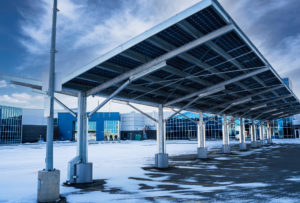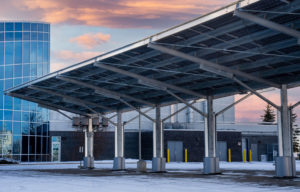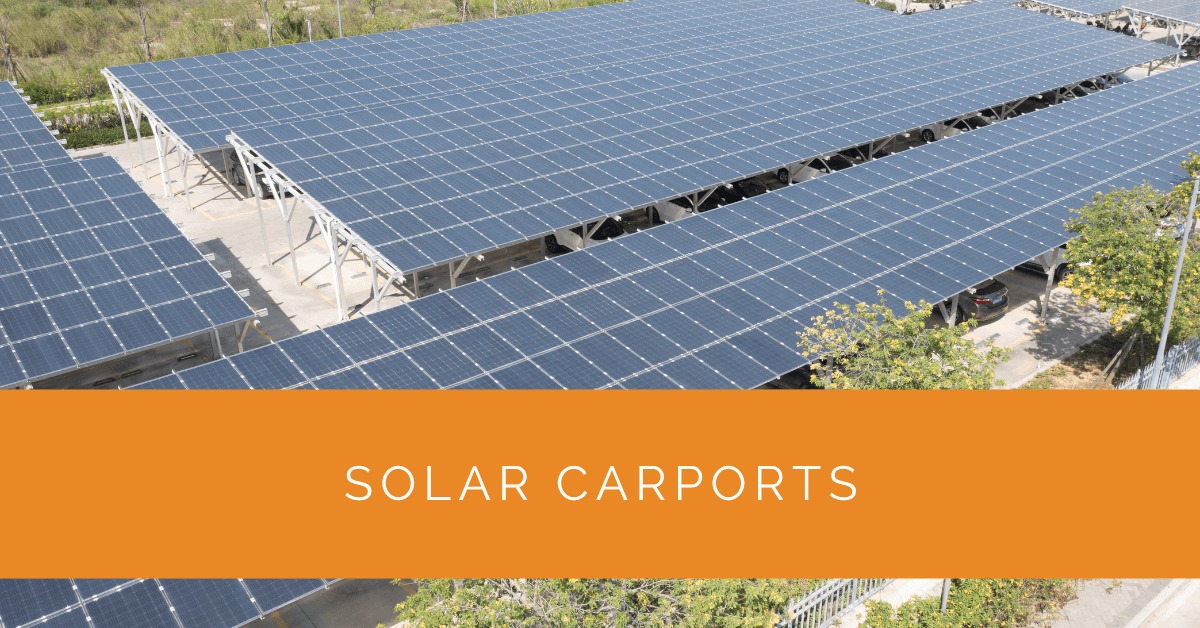Solar carports are revolutionizing how we think about parking structures and renewable energy generation. By seamlessly integrating solar panels into carport designs, these innovative installations provide shaded parking spaces while harnessing the sun’s energy to generate clean electricity. In this comprehensive guide, we will explore the ins and outs of solar carports, from their working principles to the advantages they offer, the installation process, cost factors, and incentives. Whether you’re a homeowner, business owner, or EV enthusiast, this article will equip you with the knowledge to embrace solar carports and contribute to a greener future.
Contents
- 1 Key Takeaways
- 2 How Solar Carports Work
- 3 Advantages of Solar Carports
- 4 Solar Carport Installation Process
- 5 Factors Affecting the Cost of a Solar Carport
- 6 Incentives for Solar Carports
- 7 Case Study: Implementing Solar Carports for Sustainable Energy
- 8 Expert Insights From Our Solar Panel Installers About Solar Carports
- 9 Experience Solar Excellence with Us!
- 10 Conclusion
Key Takeaways
- Solar carports integrate solar panels into parking structures, offering shaded parking spaces and clean energy generation.
- The advantages of solar carports include renewable energy production, vehicle protection, and efficient space utilization.
- Solar carports provide an innovative solution for homeowners, businesses, and EV owners to embrace sustainable energy and contribute to a greener future.
How Solar Carports Work
Solar carports harness the sun’s energy and convert it into electricity by integrating solar panels within the carport structure. The solar panels, composed of photovoltaic cells, capture sunlight and convert it into direct current (DC) electricity. This DC electricity is converted into alternating current (AC) electricity through an inverter, making it compatible with the electrical systems of buildings, EV charging stations, or the grid.
The generated electricity from the solar panels can serve multiple purposes. It can power nearby buildings, offsetting traditional energy consumption and reducing reliance on the grid. In the case of EV charging stations, solar carports provide a sustainable energy source for charging electric vehicles directly from the sun. Excess electricity can be stored in battery storage systems for later use or fed back into the grid through net metering, allowing for credit or compensation for the energy contributed.
Solar carports maximize energy production potential by utilizing parking areas and integrating solar panels into the carport design while providing covered parking spaces. This dual-purpose infrastructure offers the convenience of shaded parking and the opportunity to generate clean, renewable energy.
Advantages of Solar Carports
Solar carports offer many advantages, making them a compelling choice for homeowners, businesses, and public spaces. Beyond the obvious benefits of providing shaded parking areas and protecting vehicles from the elements, solar carports bring additional advantages:
Clean and Renewable Energy Generation
Solar carports facilitate the production of clean and renewable energy by tapping into the sun’s abundant power. By generating electricity through solar panels, carport structures contribute to reducing carbon footprints and combating climate change.
Efficient Space Utilization
Parking areas are often underutilized spaces, especially during daylight hours. Solar carports transform these idle spaces into productive and environmentally friendly energy generators, efficiently using available land or rooftop areas.
Cost Savings and Return on Investment
Investing in solar carports can yield long-term cost savings. By generating electricity on-site, carport owners can reduce their reliance on traditional energy sources and lower their utility bills. The financial benefits extend further with potential incentives, such as tax credits, grants, or rebates, which help offset the initial installation costs and enhance the return on investment.
Durability and Weather Protection
Solar carports are built to withstand various weather conditions while providing shelter for parked vehicles. The carport structures are designed with durability, using sturdy materials and engineering to withstand wind, rain, snow, or hail. This added protection contributes to extending the lifespan of vehicles and reducing maintenance costs.
Flexibility and Scalability
Solar carports offer flexibility in design and scalability. They can be customized to fit different parking area sizes, accommodating various vehicles. Solar carports can be tailored for residential, commercial, or public use to meet specific energy requirements and aesthetic preferences.

Solar Carport Installation Process
The installation process of a solar carport system involves several key steps that ensure a successful and efficient implementation:
Site Assessment and Design
A professional solar carport installer begins by assessing the site’s feasibility for a solar carport installation. Factors such as available space, orientation, shading, and structural considerations are evaluated. Based on this assessment, a suitable carport design is developed, considering the parking capacity, solar panel layout, and electrical connectivity.
Permits and Approvals
Obtaining the necessary permits and approvals is crucial before the installation can proceed. The installer coordinates with local authorities and regulatory bodies to ensure compliance with building codes, zoning regulations, and electrical standards. Permitting requirements may vary depending on the location and specific project details.
Carport Construction
Once the necessary permits are acquired, the carport construction begins. This involves erecting the carport structure according to the design specifications. The construction phase includes installing the support columns, roof framework, and additional features, such as integrated EV charging stations or lighting systems.
Solar Panel Mounting
After the carport structure is in place, the solar panels are mounted securely onto the roof framework. The positioning and alignment of the panels are crucial to maximize solar energy capture. The installer ensures the proper attachment and wiring connections to integrate the solar panels seamlessly into the carport system.
Electrical Connection and Testing
The final step involves connecting the solar panels to the electrical system. This includes wiring the solar panels to inverters that convert the DC electricity into AC electricity for immediate use or grid connection. Rigorous testing ensures the system’s functionality, efficiency, and compliance with safety standards.
By following this comprehensive installation process, solar carport systems are installed efficiently, ensuring optimal performance and longevity. Working with experienced solar carport installers is recommended to navigate the complexities of the installation process and ensure a successful outcome.

Factors Affecting the Cost of a Solar Carport
The cost of a solar carport can vary depending on several factors that influence the overall project expenses. Understanding these factors can help homeowners, businesses, and organizations plan and budget accordingly:
Size and Scale of the Solar Carport
The physical dimensions of the solar carport, including the number of parking spaces it can accommodate, significantly impact the cost. Larger carports with more solar panels require additional materials, labor, and engineering expertise, contributing to higher expenses. Additionally, the complexity of the carport design, such as incorporating custom features or architectural elements, can influence the overall cost.
Choice of Materials and Design Features
The choice of materials for the carport structure and solar panels can affect the cost. High-quality materials may have a higher upfront cost but offer increased durability and longevity, resulting in long-term savings. Design features like integrated EV charging stations, lighting systems, or energy storage solutions can add to the expenses.
Site Preparation and Electrical Infrastructure
The site’s characteristics and existing electrical infrastructure can impact the installation cost. These additional tasks can increase the overall project cost if the site requires significant preparation, such as land grading or tree removal, Similarly, upgrading or expanding the electrical system to accommodate the solar carport’s electricity generation may require additional investment.
Location and Permitting
The location of the solar carport installation plays a role in cost determination. Permitting fees, utility interconnection requirements, and local regulations can vary depending on the jurisdiction. Working with a knowledgeable solar carport installer who understands the local permitting process is essential to ensure compliance and minimize potential delays or additional expenses.
Additional Considerations for Solar Panel Installation
Factors related to the solar panel installation itself can influence the cost. This includes the type of solar panels chosen, their efficiency ratings, and the desired energy output. Higher efficiency panels generally have a higher price tag but offer improved energy production. Moreover, incorporating advanced monitoring systems or smart technologies for optimization and maintenance may incur additional costs.
It’s important to note that while upfront costs may be a consideration, a solar carport system is a long-term investment that provides significant financial and environmental benefits over its lifespan. Evaluating the total cost of ownership, including potential energy savings, incentives, and return on investment, can provide a more comprehensive understanding of the financial viability of installing a solar carport.
Incentives for Solar Carports
Investing in solar carports offers various incentives that further enhance the financial appeal of these systems. Here are some key incentives to consider:
Federal Tax Credits and Grants
The federal government offers tax incentives to encourage the adoption of renewable energy sources. The Investment Tax Credit (ITC) allows for a percentage-based credit on the total cost of the solar carport installation. Additionally, grants or funding programs may be available at the federal, state, or local levels to support renewable energy projects.
State and Local Incentive Programs
Many states and local municipalities have incentive programs to promote solar energy installations. These may include additional tax credits, cash rebates, or performance-based incentives. Researching the specific incentives available in your area can provide valuable information on potential savings and financial support.
Net Metering and Energy Buyback Programs
Net metering allows solar carport owners to earn credits for the excess electricity their systems generate. These credits can offset future energy consumption from the grid or be sold back to the utility company, effectively reducing electricity bills and potentially generating revenue.
Accelerated Depreciation and Financing Options
Businesses and commercial entities may benefit from accelerated depreciation allowances, which enable them to recover the cost of the solar carport system over a shorter period, reducing tax liability. Additionally, various financing options, such as solar loans, power purchase agreements (PPAs), or leasing arrangements, can make solar carport installations more accessible and affordable.
Exploring these incentives and calculating the overall financial benefits of reduced energy costs and potential revenue generation can help determine the feasibility and attractiveness of investing in a solar carport system.
Case Study: Implementing Solar Carports for Sustainable Energy
Background
At Solar Panels Network USA, we pride ourselves on delivering innovative solar solutions. This case study highlights our successful implementation of solar carports for a commercial parking facility, showcasing the benefits of integrating renewable energy generation with functional parking structures.
Project Overview
Our client, a large commercial property owner, sought to reduce their energy costs and environmental impact while providing shaded parking for their tenants and visitors. The goal was to install solar carports that would generate clean electricity, offer vehicle protection, and enhance the property’s overall appeal.
Implementation
Initial Site Assessment and Feasibility Study
We began with a comprehensive site assessment, evaluating the available space, sunlight exposure, and existing electrical infrastructure. Our team conducted a feasibility study to determine the optimal design and placement of the solar carports, considering the number of parking spaces and potential energy generation.
Customized Design and Planning
Based on the assessment, we designed a custom solar carport solution tailored to the client’s needs. The design included high-efficiency solar panels mounted on sturdy carport structures, strategically positioned to maximize sunlight capture and provide ample shade for parked vehicles. We incorporated integrated EV charging stations to enhance the facility’s appeal and functionality further.
Permitting and Approvals
We handled all permitting and approval processes, coordinating with local authorities to ensure compliance with building codes, zoning regulations, and electrical standards. This step was crucial to avoid delays and ensure a smooth installation process.
Construction and Installation
Our experienced installation team began constructing the carport structures, followed by securely mounting the solar panels. The electrical system was integrated, connecting the solar panels to inverters and ensuring compatibility with the existing grid. The installation also included setting up EV charging stations, providing an additional service for electric vehicle owners.
Testing and Commissioning
Once the installation was complete, we conducted rigorous testing to ensure the system’s efficiency and safety. The solar carports were commissioned, and the client received detailed instructions on system monitoring and maintenance.
Results
Renewable Energy Generation
The solar carports generated significant clean electricity, reducing the property’s reliance on traditional energy sources and lowering utility bills. The system’s performance exceeded initial estimates, providing a substantial return on investment.
Enhanced Property Appeal
The aesthetically pleasing design of the solar carports improved the property’s overall look, attracting more tenants and visitors. The added benefit of shaded parking and EV charging stations increased tenant satisfaction and occupancy rates.
Environmental Impact
The project significantly reduced the property’s carbon footprint, contributing to the client’s sustainability goals. The renewable energy generated by the solar carports helped mitigate climate change by offsetting greenhouse gas emissions.
Summary
This case study demonstrates the successful implementation of solar carports, highlighting the benefits of combining renewable energy generation with practical infrastructure. Solar Panels Network USA provided a tailored solution that met the client’s energy needs, enhanced property appeal, and contributed to environmental sustainability.
Expert Insights From Our Solar Panel Installers About Solar Carports
Solar carports are revolutionizing the way we think about parking structures and renewable energy. By integrating solar panels into carports, we can generate clean electricity while providing shaded parking spaces, maximizing both functionality and sustainability.
Senior Solar Engineer
One of the key benefits of solar carports is their flexibility in design and scalability. They can be tailored to fit various parking area sizes, making them suitable for residential, commercial, and public spaces, all while contributing to a greener future.
Lead Solar Installer
Proper installation and site assessment are crucial for solar carports. Ensuring the optimal placement of panels maximizes energy production and provides the added advantage of vehicle protection from the elements.
Solar Energy Consultant
Experience Solar Excellence with Us!
Trust in Solar Panels Network USA, where our seasoned experts deliver top-quality solar solutions for homes and businesses nationwide. With a legacy of countless successful installations and a commitment to sustainable energy, we’re your reliable partner in the solar journey. Ready for a brighter, eco-friendly future? Call us now at (855) 427-0058 and harness the power of the sun!
Conclusion
Solar carports are a smart and innovative solution that combines the practicality of carport structures with the energy generation capabilities of solar panels. They offer shaded parking areas, vehicle protection, and the opportunity to harness the sun’s energy to power homes, businesses, and electric vehicles. As solar technology advances, solar carports become an increasingly attractive option for homeowners, commercial spaces, and public areas. Embrace the power of solar energy and experience the benefits solar carports offer.
We can generate clean and renewable energy by installing solar carports while utilizing parking spaces efficiently. Let solar carports be the driving force toward a sustainable future.
About the Author
Solar Panels Network USA stands at the forefront of solar energy solutions, driven by a team of seasoned solar engineers and energy consultants. With over decades of experience in delivering high-quality solar installations and maintenance, we are committed to promoting sustainable energy through customer-centric, tailored solutions. Our articles reflect this commitment, crafted collaboratively by experts to provide accurate, up-to-date insights into solar technology, ensuring our readers are well-informed and empowered in their solar energy decisions.

